South American Rattlesnake
Rattlesnakes are among the most iconic snakes of the Americas. However, they're not restricted to just North America. Central and South America have their own versions too. The neotropical rattlesnake (AKA: South American rattlesnake) is found across almost all South American countries.
There are nine recognised sub-species of the South American rattlesnake (crotalus durissus) as follow:
The cascavel has a powerful stocky appearance. Adults typically measure around 1.5 m (4.9 ft) long - although will occasionally reach 1.9 m (6 ft). They're dark green or brown with prominent zig-zag or diamond patterning along their back, margined with lighter colours. There are dark stripes extending lengthwise from the base of their head to their upper dorsal area, and the underside is lighter in colour.
- Venezuelan rattlesnake - C. d. cumanensis
- Guyana rattlesnake - C. d. durissus
- Marajon rattlesnake - C. d. marajoensis
- Maricela rattlesnake - C. d. maricelae
- Mount Roraima rattlesnake - C. d. ruruima
- Cascavel - C. d. terrificus
- Rupunini rattlesnake - C. d. trigonicus
- Aruba Island rattlesnake - C. d. unicolor
- Uracoan rattlesnake - C. d. vegrandis
Appearance
The cascavel has a powerful stocky appearance. Adults typically measure around 1.5 m (4.9 ft) long - although will occasionally reach 1.9 m (6 ft). They're dark green or brown with prominent zig-zag or diamond patterning along their back, margined with lighter colours. There are dark stripes extending lengthwise from the base of their head to their upper dorsal area, and the underside is lighter in colour.
- Older individuals will sometimes also have a raised dorsal ridge.
- Males are slightly larger than females.
- Although the "rattle" on South American rattlesnake species isn't as large as that of their northern cousins, its still functional and visible.
- The scales have a rough or beaded texture in contrast to that of most other south american snakes.
South American rattlesnake (cotalus durissus terrificus) displaying its thick stocky body and distinctive pattern. Photo: José Reynaldo da Fonseca/Wikimedia.
Venom and Bites
Rattlesnakes are among the most dangerous snakes in the Americas - with Cascavel being possibly the most dangerous of the group. South American rattlesnakes differ from their northern cousins by possessing a venom which is doubly worrying. Most snake venoms act either on tissues (haemorrhagic) or on the nervous system (neurotoxic) - whereas the venom of the cascavel unfortunately does both. Although the cascavel isn't naturally aggressive, it is willing to defend itself if threatened - and is one of the species most likely to around in grasslands and farms. For this reason, its the second-greatest cause of snake envenoming in Brazil after the Lancehead. In the first half of the 20th century and through into the 1960s, about 12% of treated cases still ended fatally. In untreated cases, the mortality rate was much higher - at 72%. Fortunately, with better treatments and better access to medical facilities, the situation has improved. An average of 20,000 snakebites are now recorded in Brazil annually, with around 10% of them attributed to the cascavel. Of these, the overall mortality rate is estimated as 3.3%. The danger depends on the amount of venom injected, and the physical size and general health of the victim - as well as the time taken to get medical treatment.
The chemical make-up and proportion of toxins within cascavel venom has been found to vary slightly depending on the region and the age of the snake. Bites have have been known to result in blindness or impaired vision, auditory problems, or paralysis of peripheral muscles. Skeletal and heart muscles can also be affected causing aches, pain and tenderness throughout the body. However, despite their lethal nature, snake venoms are also a treasure trove for medical research. Brazilian researchers have identified new proteins (such as crotamine) within the cascavel's venom - revealing potential uses to assist the fight against tumours, melanoma, and other cancers.
Related Links
Scientific Name
Crotalus durissus terrificus

Local Name
Cascavel

Description
Thick and stocky snake measuring around 1.5 m in length when adult. Dark green or brown with prominent zig-zag or diamond patterning along the back. Scales have a rough or beaded appearance.
Behaviour and Habitat
Cascavel rattlesnakes prefer hot dry open areas and grasslands, such the Brazilian cerrado, and are generally absent from rainforest areas such as the Amazon on Mata Atlantica. However, they do inhabit "transition" areas within the Pantanal, which are dry for a good portion of the year. Although some Pantanal regions will flood in the wet season, there are often nearby high-ground areas where cascavels (and other wildlife) can migrate to avoid getting caught in the flood waters. Notably, cascavels are territorial, and generally seek to return to the spots near where they were born.
Cascavels are largely nocturnal. Their peak activity occurs after sunset, between 6 and 9 pm, when its still warm and other nocturnal animals such as small rodents come out to to feed. The darkness helps the snakes to stay hidden while using their heat sensors to full advantage - locating and identifying prey. A common trick is to lie in wait along the trails that small mammals re-use on a frequent basis, quickly striking when their potential meal strays close. The snake will typically positioned themselves into an L-shape, allowing them to lunge at their prey simply by moving their head sideways rather than attempting to jump their body forwards. When striking, the long hinged fangs near the front of the cascavel's mouth are automatically pulled forward by their check muscles as their mouth opens wide. Prey is released after the strike, and is allowed to crawl away rather than allowing it to potentially damage the snake. The snake will pursue afterwards, eating it once it is dead.
Cascavels will also hunt occasionally in the day, but are more likely to spend their daytime hours resting in quiet refuges, or basking in the warmth of the sun to recharge their energy.
Reproduction
Cascavels are solitary except during the mating season. This occurs in the autumn months (April-June). Its marked by ritualised sparring between the male cascavels, which presumably helps the winners gain access to females. Not all females will be available to breed, as some recent research suggests that females follow a bi-annual or even tri-annual cycle. For the females, reproduction can mean an extended period of around five months without hunting or eating through the gestation period. The act of copulation can last an entire day - albeit with some interruptions.
Like other rattlesnakes, cascavels give are viviparous, giving birth to live young. This occurs around five months after mating, in the spring. The litter or clutch consists of 15-30 new-borns are fully venomous, independent - and able to start catching their own prey. The young snakes are preyed upon by hawks and other snakes (e.g. coral snakes). Should they reach adulthood, a typical lifespan is around 15 years, although they can live longer in captivity.
Threats and Conservation
Although cascavels aren't considered a threatened species, they're not particularly common (which most people might consider a good thing). Their numbers may be diminishing and development and large-scale agriculture increase within Brazil, reducing natural habitats such as the cerrado. Cascavels are typically killed on sight by cattle ranchers and farm workers. This is due both to the risk presented to humans, as well as to livestock.
Quick Facts
- Snake venom, including that of rattlesnakes, was a common means for native americans to produce poison for the arrows used in warfare. One method was to cause one or multiple snakes to bite into an animal liver (e.g. from a deer). This was left to putrefy and increase the toxicity. Arrow points were then smeared with the end product. It was said that one liver could poison a thousand arrowheads. Others tribes dipped their arrows directly into the venom glands of a recently-killed snake so that it dried like varnish.
- Native Mexican doctors used rattlesnake fangs as lancets, applied at the back of their patients' neck to relieve headaches.
- Brazil's Butantan Institute, founded in 1901, has a world-renowned reputation as a researcher and producer of anti-venoms, including that for South American rattlesnakes. The Institute was an important first-stop for explorers, such as Colonel Fawcett, to learn about the region's and stock up on anti-venoms before setting off into the wilds of Brazil.



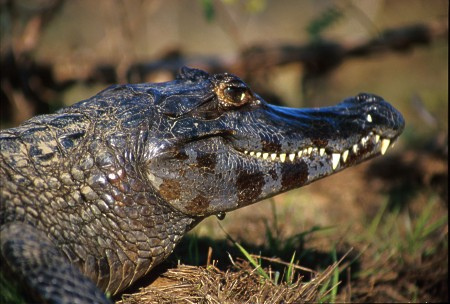
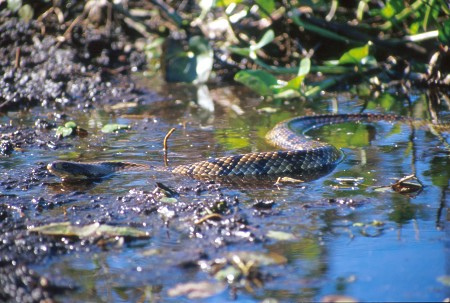
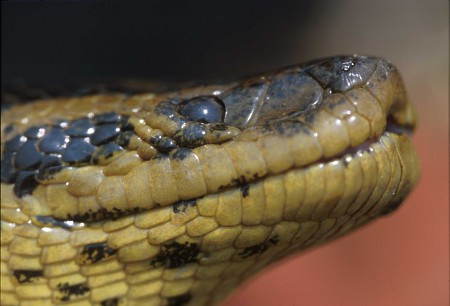


Banner image: South American Rattlesnake (Shutterstock/Dmitri Gomon).
Crotalus durissus terrificus (Wikimedia Commons/José Reynaldo da Fonseca); Footer images: Jacaré; Anaconda; False Water Cobra (Andrew Mercer)
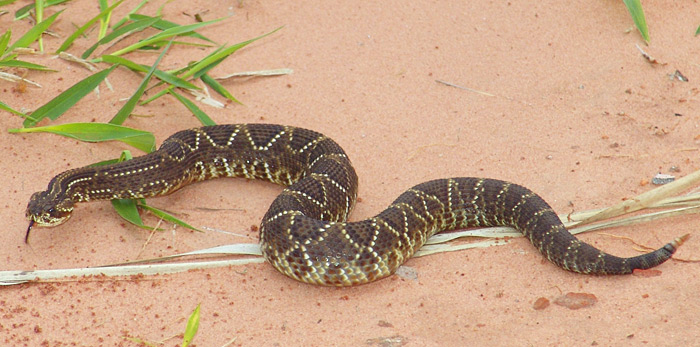
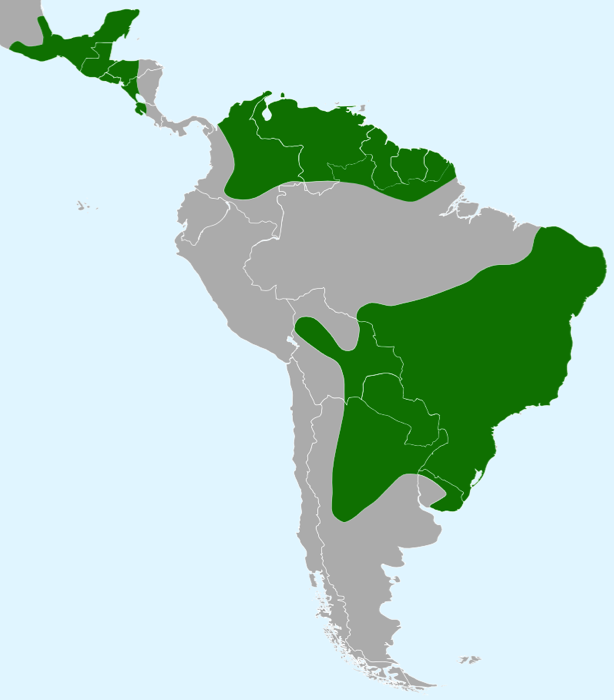
Pantanal Escapes